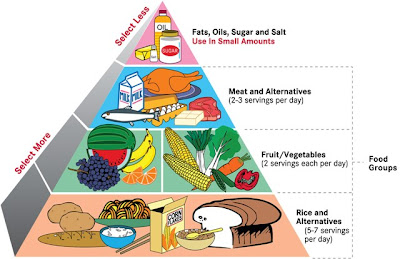Good nutrition can help you achieve good health without having to sacrifice great-tasting food. Eating healthfully can help you work more productively, perform better athletically, maintain or reduce your weight, and dramatically lower your risk for heart disease and certain forms of cancer. A healthy diet is one that is well balanced, low in fat, high in fiber, and rich in whole grains, vegetables, and fruits. To consume a healthy diet, you need to choose foods that provide all the nutrients your body needs without an excess of fat, sugar, or calories. No matter what your lifestyle, the Food Guide Pyramid is your best guide to making healthy food choices. Developed by the US Department of Agriculture, the Food Guide Pyramid is meant to be a general outline for healthy eating, not rigid dietary prescription. It helps you choose the most nutritious foods in the correct proportions. The Food Guide Pyramid arranges all foods into five food groups—grains; vegetables and fruits; dairy; meat, poultry, and other protein foods; and fats, oils, and sweets. The grains group is at the base of the pyramid because it is the foundation of good nutrition. The Food Guide Pyramid conveys three concepts about healthful eating: balance, variety, and moderation. To eat a balanced diet, consume more foods from the groups at the bottom of the pyramid and fewer from those near the top.
Achieve variety in your diet by sampling an assortment of foods from the different pyramid groups and a variety of foods within each food group. Practice moderation by eating neither too much nor too little of any food. The Food Guide Pyramid contains four levels that symbolize the importance of certain foods in your overall diet. At the bottom lies the bread, cereal, rice, and pasta group—all foods made from grains. This group is the largest of the food groups in the pyramid because grain-based foods should make up the
largest proportion of the food in your diet. You should consume six to 11 servings of bread, cereal, rice, and pasta each day. A serving is one slice of bread, 1 ounce of ready-to-eat cereal, or half a cup of cooked cereal, rice, or pasta. Grain foods contain complex carbohydrates, which are an excellent source of
energy, and many grain products are enriched with B vitamins and iron. Most grain foods are also low in fat and cholesterol. Whole-grain foods, such as brown rice, whole wheat or multigrain breads, and bran cereal, also supply fiber, which has been shown to help lower blood cholesterol and which may reduce your risk for certain forms of cancer, such as colon cancer. Try to obtain at least half of your daily grain servings (at least three servings) from whole-grain foods. The second level (from the bottom) of the pyramid contains the vegetable and fruit groups. The Food Guide Pyramid recommends that you eat three to five servings of vegetables and two to four servings of fruits each day—more vegetables than fruits because vegetables contain a wider variety of vitamins and minerals than do fruits. A serving is a cup of raw, leafy vegetables; half a cup of other vegetables, either cooked or chopped raw; one medium apple, orange, or banana; half a cup of chopped, cooked, or canned fruit; or 3⁄4 cup of vegetable or fruit juice. The nutrients in vegetables and fruits vary considerably, so it is important to include a wide variety of these foods in your diet. However, many vegetables and fruits are rich in the antioxidant vitamins, E, C, and beta carotene (which converts to vitamin A in your body). Antioxidants (see page 9) may have the potential to lower your risk for heart disease. The milk, yogurt, and cheese group appears on the same level of the Food
Guide Pyramid as the meat, poultry, fish, dry beans, eggs, and nuts group. Two to three daily servings of both dairy products and protein foods are suggested for good health. Dairy foods are an important source of calcium but can be high in fat, especially saturated fat, so you need to choose low-fat or fat-free varieties of
milk, yogurt, and cheese. You may be surprised that dried beans and nuts are grouped together with meat and poultry, but all these foods supply protein and the same kinds of nutrients, such as iron, zinc, and the B
vitamins. A serving is 1 cup of milk or yogurt; 11⁄2 to 2 ounces of cheese; or 2 to 3 ounces of cooked lean meat, poultry, or fish. (Half a cup of cooked dry beans, one egg, or 2 tablespoons of peanut butter count as 1 ounce of lean meat.) It is important for middle-aged or older men to become accustomed to the idea of eating a small portion (2 to 3 ounces) of meat or poultry. At the top of the pyramid sits the smallest food group, made up of fats, oils, and sweets. It is best to consume foods high in fat and sugar only sparingly.
High-fat foods contribute to the development of heart disease, and sugar contains many nutritionally empty calories. Overindulgence in foods from this group may lead to excess weight gain. The bottom line is that a healthy diet can keep you healthy. But don’t worry if you eat a high-fat cheeseburger or a sugary dessert once in a while. The important thing is to balance your diet over weeks or months so your overall diet is
healthy. To make sure you are consuming a wide variety of foods, be adventurous. Try bok choy or bulgur if you’ve never had it before. Experiment with exotic herbs and spices to enliven the flavor of foods, both new and familiar. And be sure to balance what you eat with physical activity to maintain your proper
body weight.





